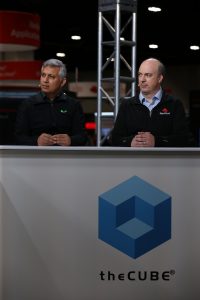 CLOUD
CLOUD
 CLOUD
CLOUD
 CLOUD
CLOUD
With disparate cloud operations, edge computing, open-source software supply chains and artificial intelligence the norm, data protection and resilience have become top-of-mind enterprise concerns. To address those concerns, Red Hat Inc. has partnered with Veeam Software Group GmbH for advanced data protection solutions for workload virtualization.
“We have 450,000 customers [and] a lot of them use virtual machines and that’s what we back up,” said Gaurav Rishi (pictured, left), vice president of product at Veeam. “One of the tenets for us has always been data freedom. Here we are as Kasten, which was a Kubernetes-centric product, and now we are seeing virtual machines come in there. And so right time, right place — and no better partner than Red Hat to be able to go enable that.”
Rishi and Stu Miniman (right), senior director of market insights, hybrid platforms, at Red Hat, spoke with theCUBE Research’s Rebecca Knight and Rob Strechay at Red Hat Summit, during an exclusive broadcast on theCUBE, SiliconANGLE Media’s livestreaming studio. They discussed Veeam adapting to the shifting landscape with the rise of containers, particularly in OpenShift environments. (* Disclosure below.)

Veeam’s Gaurav Rishi and Red Hat’s Stu Miniman discuss the Kasten integration with OpenShift for resilient virtualization.
Both companies share the ethos of meeting customers where they are, recognizing that each organization’s journey is unique. Many organizations are now embracing OpenShift virtualization and the partnership between Veeam (through Kasten) and Red Hat aims to provide the necessary tools and support for this transition. Key customers such as the US Navy and Zenseact have already made significant strides in adopting containerization alongside virtual machines, Rishi pointed out.
“We’ve got serious customers now who are actually virtual machine customers and now have containers running in OpenShift platforms,” he said. “We’ve talked about the US Navy, for example. It doesn’t get more serious than that. They use virtual machines and now they have containers on OpenShift.”
One of the major challenges faced by customers is the complexity of migration. While the shift to modern environments is essential, it requires careful planning and execution. Tools such as the Migration Toolkit for Virtualization and deep integrations with Ansible are crucial in streamlining this process and ensuring a smooth transition.
“We’ve actually been doing some deep integration between Ansible and what we’ve been doing on the OpenShift side to help with that migration,” Miniman said. “We know we need to automate this, because otherwise, that long migration will take even longer. A lot of customers are sitting on the clock and trying to make these things.”
Here’s the complete video interview, part of SiliconANGLE’s and theCUBE Research’s coverage of Red Hat Summit:
(* Disclosure: Veeam Software Group GmbH sponsored this segment of theCUBE. Neither Veeam nor other sponsors have editorial control over content on theCUBE or SiliconANGLE.)
Support our mission to keep content open and free by engaging with theCUBE community. Join theCUBE’s Alumni Trust Network, where technology leaders connect, share intelligence and create opportunities.
Founded by tech visionaries John Furrier and Dave Vellante, SiliconANGLE Media has built a dynamic ecosystem of industry-leading digital media brands that reach 15+ million elite tech professionals. Our new proprietary theCUBE AI Video Cloud is breaking ground in audience interaction, leveraging theCUBEai.com neural network to help technology companies make data-driven decisions and stay at the forefront of industry conversations.